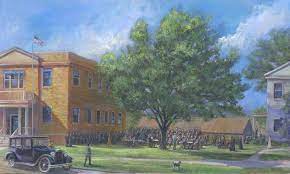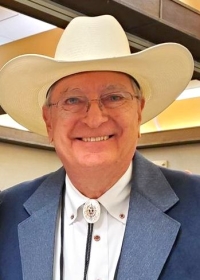The Million Dollar Elm
Jun 06, 2023 by E. Joe Brown
Some key scenes in the Kelly Can Saga Series happen in Pawhuska, Oklahoma, on top of Agency Hill under a large elm tree between the county courthouse and the Osage tribal house.

Today this famous tree would be located east of the Osage Nation Tribal Museum in Pawhuska, Osage County, Oklahoma. The Million Dollar Elm was the site of public oil and natural gas lease auctions starting in November 1912. Colonel Ellsworth Walters, who lived in Skedee in Pawnee County, Oklahoma, was the official auctioneer for the Osage Nation beginning in 1916. Typically the auctions he oversaw started at 10:30 a.m. and often continued late into the evening. You would usually have found such notable oilmen as J. Paul Getty, Frank Phillips, Waite Phillips, William G. Skelly, Harry Sinclair, and E. W. Marland in attendance. Marland was a business partner of the Millers who owned the 101 Ranch, and he and the Millers were central characters in Kelly Can Saga's story. Beneath this tree, there were millions of dollars bid, thus its designation as the "Million Dollar Elm."
By the time the Million Dollar Elm appears in the Kelly Can storyline, oil discoveries in Osage County had brought thousands to Bartlesville, Hominy, Fairfax, and Burbank. All of these oilfields produced high-quality, easily refined oil. I chose the Burbank field to focus Kelly Oil on because it was near the 101 Ranch. First drilled around 1920, the Burbank field and several others soon became one of the richest in Oklahoma.

At its peak, the Burbank oilfield produced more than 70,000 barrels daily from more than 1,800 wells. Phillips Petroleum made a fortune there. Other petroleum companies got their start in Osage oilfields, including Conoco (originally Marland Oil), Skelly Oil, Carter Oil (later incorporated into Standard Oil), and Gypsy Oil Company (later Gulf).
By the time Kelly Oil became active in the storyline, the most significant years of the Osage boom were starting. The demands of World War I and the growth of the use of automobiles triggered the boom. Regarding the elm, Osage tribal leaders didn't name it, but reporters and magazine writers reported on the events when the millionaire owners of the large oil companies came in person to bid. It had earned its name well before Charlie and his business partner Hank Thomas
arrived.
The oil business becomes very important as Charlie's story continues into the second novel, A Cowboy's Gusher (Book 2 - Kelly Can Saga).
Happy Trails,
Joe
**You can find "A Cowboy's Destiny" here --> Barnes & Noble | Bookshop | Amazon

Today this famous tree would be located east of the Osage Nation Tribal Museum in Pawhuska, Osage County, Oklahoma. The Million Dollar Elm was the site of public oil and natural gas lease auctions starting in November 1912. Colonel Ellsworth Walters, who lived in Skedee in Pawnee County, Oklahoma, was the official auctioneer for the Osage Nation beginning in 1916. Typically the auctions he oversaw started at 10:30 a.m. and often continued late into the evening. You would usually have found such notable oilmen as J. Paul Getty, Frank Phillips, Waite Phillips, William G. Skelly, Harry Sinclair, and E. W. Marland in attendance. Marland was a business partner of the Millers who owned the 101 Ranch, and he and the Millers were central characters in Kelly Can Saga's story. Beneath this tree, there were millions of dollars bid, thus its designation as the "Million Dollar Elm."
By the time the Million Dollar Elm appears in the Kelly Can storyline, oil discoveries in Osage County had brought thousands to Bartlesville, Hominy, Fairfax, and Burbank. All of these oilfields produced high-quality, easily refined oil. I chose the Burbank field to focus Kelly Oil on because it was near the 101 Ranch. First drilled around 1920, the Burbank field and several others soon became one of the richest in Oklahoma.

At its peak, the Burbank oilfield produced more than 70,000 barrels daily from more than 1,800 wells. Phillips Petroleum made a fortune there. Other petroleum companies got their start in Osage oilfields, including Conoco (originally Marland Oil), Skelly Oil, Carter Oil (later incorporated into Standard Oil), and Gypsy Oil Company (later Gulf).
By the time Kelly Oil became active in the storyline, the most significant years of the Osage boom were starting. The demands of World War I and the growth of the use of automobiles triggered the boom. Regarding the elm, Osage tribal leaders didn't name it, but reporters and magazine writers reported on the events when the millionaire owners of the large oil companies came in person to bid. It had earned its name well before Charlie and his business partner Hank Thomas
arrived.
The oil business becomes very important as Charlie's story continues into the second novel, A Cowboy's Gusher (Book 2 - Kelly Can Saga).
Happy Trails,
Joe
**You can find "A Cowboy's Destiny" here --> Barnes & Noble | Bookshop | Amazon
_w200_h/A%20Cowboy's%20Dilemma%20-%20Ebook%20Cover%20(1)_06280522.jpg)
